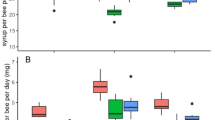Abstract
Occurrence inLepidoglyphus destructor of a facultative developmental stage (hypopus) adapted for dispersal and dormancy depends on genotype x environment interaction. Dietary factors affect hypopus formation, but the response of individuals to food quality greatly differs according to genotype. Large genetic variation in the control of hypopus formation exists within as well as between populations. Response to selection is rapid and reversible. The trait has substantial potential for selective adaptation to unpredictably varying environments and for evolutionary change.
Similar content being viewed by others
References
Barker, P.S., 1982. Control of a mite,Lepidoglyphus destructor, including hypopi, in wheat with carbon disulfide. J. Econ. Entomol., 75: 426–439.
Boczek, J. and Cross, E.A., 1983. Reproductive isolating mechanisms in two sibling species of mites (Acarus siro, A. farris) (Acari: Astigmata) commonly found together in stored grain. Ann. Entomol. Soc. Am., 76: 552–555.
Chmielewski, W., 1975. Interspecific hybridization of mites belonging to the superfamily Acaroidea and some biological features of hybrids. Zesz. Probl. Postepow Nauk Roln. (Warszawa), 171: 189–211 (in Polish, with English abstract).
Chmielewski, W., 1977. Formation and importance of hypopus stage in the life of mites belonging to the superfamily Acaroidea. Prace Naukowe Instytutu Ochrony Róslin, 19: 5–94 (in Polish, with English abstract).
Chmielewski, W., 1983a. Formation and transformation of hypopi of mites ofAcarus genus under different environmental conditions. Zesz. Probl. Postepow Nauk Roln. (Warszawa), 252: 147–160 (in Polish, with English abstract).
Chmielewski, W., 1983b. Bee bred as a food of tyroglyphids ofAcarus genus (Acarina: Acaridae). Zesz. Probl. Postepow Nauk Roln. (Warszawa), 252: 171–178 (in Polish, with English abstract).
Cunnington, A.M., 1984. Resistance of the grain miteAcarus siro L. (Acarina, Acaridae) to unfavourable physical conditions beyond the limits of its development. Agric. Ecosyst. Environ., 11: 319–339.
Dingle, H., 1984. Behavior, genes, and life histories: complex adaptations in uncertain environments. In: P.W. Price, C.N. Slobodchikoff and W.S. Gaud (Editors), A New Ecology: Novel Approaches to Interactive Systems. John Wiley, New York, pp. 169–194.
Fain, A. and Philips, J.R., 1981. Astigmatic mites from nests of birds of prey in U.S.A. VI. The adult forms ofEchimyopus orphanus Fain and Philips, 1977 andDermacarus pilitarsus Fain and Philips, 1977. Int. J. Acarol., 7: 235–237.
Falconer, D.S., 1981. Introduction to Quantitative Genetics. Longman, London and New York, 2nd edn., 340 pp.
Griffiths, D.A., 1962. Flour mite,Acarus siro L., 1758, as a species complex. Nature, 196: 908.
Griffiths, D.A., 1964a. A revision of the genusAcarus L., 1758 (Acaridae, Acarina). Bull. Br. Mus. Nat. Hist. Zool. Ser., 11: 415–464.
Griffiths, D.A., 1964b. Experimental studies on the systematics of the genusAcarus Linnaeus, 1758 (Sarcoptiformes, Acarina). Proc. 1st Int. Congr. Acarol., Fort Collins, U.S.A., 1963, Acarologia, 6, Suppl. Part, pp. 101–116.
Griffiths, D.A., 1966. Nutrition as a factor influencing hypopus formation in theAcarus siro species complex (Acarina, Acaridae). J. Stored Prod. Res., 1: 325–340.
Griffiths, D.A., 1969. The influence of dietary factors on hypopus formation inAcarus immobilis Griffiths (Acari, Acaridae). In: G.O. Evans (Editor), Proc. 2nd Int. Congr. Acarol., Sutton Bonington, England, 1967, Akadémiai Kiadó, Budapest, pp. 419–432.
Hagstrum, D.W. and Silhacek, D.L., 1980. Diapause induction inEphestia cautella: an interaction between genotype and crowding. Entomol. Exp. Appl., 28: 29–37.
Harrison, R.G., 1979. Flight polymorphism in the field cricketGryllus pennsylvanicus. Oecologia, 40: 125–132.
Harrison, R.G., 1980. Dispersal polymorphisms in insects. Annu. Rev. Ecol. Syst., 11: 95–118.
Hoy, M.A., 1978. Variability in diapause attributes of insects and mites: some evolutionary and practical implications. In: H. Dingle (Editor), Evolution of Insect Migration and Diapause. Springer-Verlag, New York, pp. 101–126.
Hughes, A.M., 1976. The mites of stored food and houses. HMSO, London, Ministry Agric. Fish. Food, Tech. Bull., 9: 1–400.
Hughes, T.E., 1964. Neurosecretion, ecdysis, and hypopus formation in the Acaridei. Proc. 1st Int. Congr. Acarol., Fort Collins, U.S.A., 1963, Acarologia, 6, Suppl. Part, pp. 338–342.
Istock, C.A., 1981. Natural selection and life history variation: theory plus lessons from a mosquito. In: R.F. Denno and H. Dingle (Editors), Insect Life History Patterns: Habitat and Geographic Variation. Springer-Verlag, New York, pp. 113–127.
Istock, C.A., 1983. The extent and consequences of heritable variation for fitness characters. In: C.E. King and P.S. Dawson (Editors), Population Biology. Columbia University Press, New York, pp. 61–96.
Istock, C.A., 1984. Boundaries to life history variation and evolution. In: P.W. Price, C.N. Slobodchikoff and W.S. Gaud (Editors), A New Ecology: Novel Approaches to Interactive Systems. John Wiley, New York, pp. 143–168.
Knülle, W., 1959. Morphologische und entwicklungsgeschichtliche Untersuchungen zum Phylogenetischen System der Acari: Acariformes Zachv. II. Acaridiae: Acaridae. Mitt. Zool. Mus. Berlin, 35: 347–417.
Knülle, W., 1963. Die Dauerformenbildung bei der Mehlmilbe. Naturwissenschaften, 50: 160–161.
Lawohnus, H., 1984. Induktion und Termination des Hypopusstadiums vonGlycyphagus destructor (Schrank, 1781) (Astigmata: Glycyphagidae) unterschiedlicher Standorte. Thesis, Institute of Applied Zoology, Free University of Berlin, 74 pp.
OConnor, B.M., 1982. Evolutionary ecology of astigmatic mites. Annu. Rev. Entomol., 27: 385–409.
Stratil, H.U., 1983. Untersuchungen über die Induktion des Hypopusstadiums bei der im Lagergetreide vorkommenden MilbeGlycyphagus destructor (Schrank, 1781) (Astigmata:Glycyphagidae). Inaugural Dissertation, Free University of Berlin, 93 pp.
Stratil, H.U. and Knülle, W., 1985. Die Induktion des Hypopusstadiums bei der im Lagergetreide vorkommenden MilbeGlycyphagus destructor (Schrank, 1781) (Astigmata, Glycyphagidae). Z. Angew. Entomol., 99: 350–365.
Tauber, C.A. and Tauber, M.J., 1981. Insect seasonal cycles: genetics and evolution. Annu. Rev. Entomol., 12: 281–308.
Tauber, M.J., Tauber, C.A. and Masaki, S., 1984. Adaptations to hazardous seasonal conditions: dormancy, migration, and polyphenism. In: C.B. Huffaker and R.L. Raab (Editors), Ecological Entomology. John Wiley, New York, pp. 149–183.
Author information
Authors and Affiliations
Rights and permissions
About this article
Cite this article
Knülle, W. Genetic variability and ecological adaptability of hypopus formation in a stored product mite. Exp Appl Acarol 3, 21–32 (1987). https://doi.org/10.1007/BF01200410
Accepted:
Issue Date:
DOI: https://doi.org/10.1007/BF01200410




